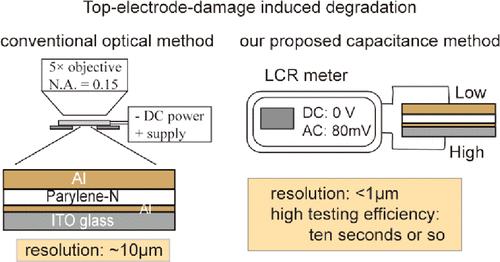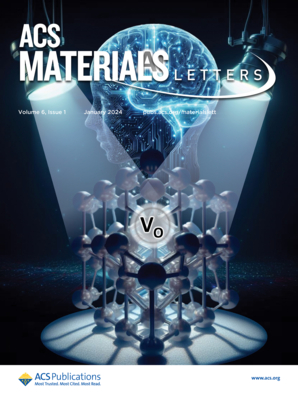Capacitance Measurement for Evaluating the Initial Top-Electrode-Damage-Induced Degradation of Organic Devices
IF 9.6
1区 化学
Q1 MATERIALS SCIENCE, MULTIDISCIPLINARY
引用次数: 0
Abstract
The formation of bubbles and fractures on the top electrode surface is one of the key factors that leads to the degradation of organic devices. This degradation can be directly observed through optical microscopy but only in low spatial resolution of several micrometers due to limited optical contrast between the bubbles and their surroundings. Here, we present a nonintrusive capacitance method to characterize electrode damage with improved accuracy and testing efficiency. For serious degradation with a large damage area at the top electrode (almost more than 10 μm), the relative drop in capacitance after degradation is consistent with the results derived by optical microscopy. For initial degradation with a damage area below the resolution of optical microscopy (even less than 1 μm), our proposed capacitance method still works well, which is validated by atomic force microscopy results.

电容测量用于评估有机器件顶部电极损坏引起的初始降解
顶部电极表面气泡和裂缝的形成是导致有机器件降解的关键因素之一。这种降解可以通过光学显微镜直接观察到,但由于气泡及其周围环境之间的光学对比度有限,因此空间分辨率很低,只有几微米。在此,我们提出了一种非侵入式电容方法,用于表征电极损伤,提高了准确性和测试效率。对于顶部电极损坏面积较大(几乎超过 10 μm)的严重降解,降解后电容的相对下降与光学显微镜得出的结果一致。对于损伤面积低于光学显微镜分辨率(甚至小于 1 μm)的初始降解,我们提出的电容计算方法仍然有效,原子力显微镜的结果也验证了这一点。
本文章由计算机程序翻译,如有差异,请以英文原文为准。
求助全文
约1分钟内获得全文
求助全文
来源期刊

ACS Materials Letters
MATERIALS SCIENCE, MULTIDISCIPLINARY-
CiteScore
14.60
自引率
3.50%
发文量
261
期刊介绍:
ACS Materials Letters is a journal that publishes high-quality and urgent papers at the forefront of fundamental and applied research in the field of materials science. It aims to bridge the gap between materials and other disciplines such as chemistry, engineering, and biology. The journal encourages multidisciplinary and innovative research that addresses global challenges. Papers submitted to ACS Materials Letters should clearly demonstrate the need for rapid disclosure of key results. The journal is interested in various areas including the design, synthesis, characterization, and evaluation of emerging materials, understanding the relationships between structure, property, and performance, as well as developing materials for applications in energy, environment, biomedical, electronics, and catalysis. The journal has a 2-year impact factor of 11.4 and is dedicated to publishing transformative materials research with fast processing times. The editors and staff of ACS Materials Letters actively participate in major scientific conferences and engage closely with readers and authors. The journal also maintains an active presence on social media to provide authors with greater visibility.
 求助内容:
求助内容: 应助结果提醒方式:
应助结果提醒方式:


